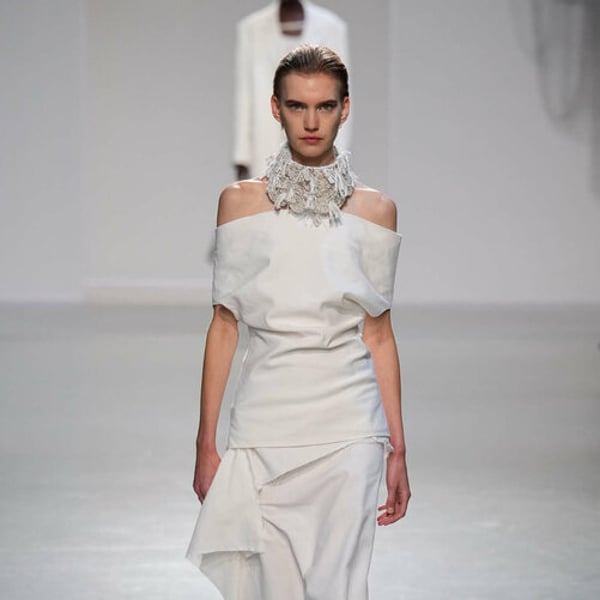Blog
Paris: Creativity takes centre stage with Niccolò Pasqualetti, Chloé and McQueen

Published
October 5, 2025
As Paris Fashion Week, dedicated to womenswear, enters the home straight, it is still serving up a few pleasant surprises. On Sunday, it spotlighted three designers with visions as inventive as they are distinct, who unveiled particularly alluring Spring/Summer 2026 collections marked by unbridled creativity: Niccolò Pasqualetti, Chloé and McQueen.
Niccolò Pasqualetti once again dazzled with his command of cut and his knack for making the most sophisticated constructions look effortless. The collection, elegant in its rigour and inflected with precious details, strikes a measured balance between tailoring and fluidity, absence and abundance, substance and transparency, sharp and softer lines, neutral hues and shimmer.
Like modern-day vestals, the models, dressed head-to-toe in white, moved with grace in tunics, loose trousers and longline ensembles with austere yet intriguingly original cuts. Raw-edged cotton panels were draped directly onto the body, baring the shoulders. Simple squares, joined with just a few stitches, form blouses, dresses and cut-out skirts.
Liquid-look sarong-style skirts, covered in sequins, sat over the hips of an asymmetric swimsuit (two pieces in one). A T-shirt cut like a bodysuit, in white cotton or black leather, read at the back as an inverted jacket, leaving a deep neckline between its two lapels, into which an eye-catching chain necklace plunges.
Leather appeared in substantial jackets with removable, interchangeable sleeves, as well as in dresses and skirts, and was also worked into fine braids edged with charms on certain chic dresses and jackets. Metallic details made their presence felt, such as a huge safety pin that acts as a back belt on a trench coat or as a bag handle, and a shamrock-patterned chainmail bralette.
At Chloé, the mood was chic and springlike, with an explosion of floral prints in every conceivable colour and motif. Designer Chemena Kamali unrolled metres of poplin, dipping into an extraordinary collection of variegated fabrics to drape with abandon. Nothing was off limits: cocktail dresses with oversized bows, skirts with basques and ruffles, peasant dresses ruffled, gathered or smocked, little floaty blouses, balloon sleeves, and more.
The effect was striking. After her first collections of diaphanous delicacy, the creative director appeared to pivot this season in quite the opposite direction. The flamboyance recalled the 1980s, an impression heightened by looks such as a run of tapered trousers worn with brightly coloured, chunky-knit boat-neck jumpers, draped leather skirts, and collarless, buttoned jackets with pronounced shoulders, cinched at the waist with a thick leather ribbon tied in a large bow.
The wardrobe was rounded out by ample, airy raincoats in monochrome camel, grey or pastels, sometimes drawn into gathers just above the knee to create ballooning volumes.
“I wanted to explore what the idea of couture means in the context of Chloé. A paradox for a house founded on the principles of democratic freedom and ease; something that is not part of the core of its DNA”, explained the German designer in her statement of intent, adding that she wanted to take the brand “into new, unexplored territory by asking why and how Gaby Aghion founded Chloé.”

At McQueen, François-Henri Pinault has ceded his place in the front row to new Kering boss Luca de Meo. Times are changing, as illustrated by the passing of the baton over the past few seasons between Sarah Burton, who left for Givenchy, and the young Irish designer Seán McGirr, who succeeded her in September 2023. McGirr drew on the provocative, tormented heritage of Alexander McQueen and the refined technicality of Sarah Burton in a collection that ranges across registers, from a military vein to decadent aristocracy and a hyper-sexy boudoir sensibility.
The designer wielded scissors like a sabre, scoring garments with box-cutter slashes. Particularly at the lower back, he revealed the top of the buttocks and a golden, jewelled thong that protrudes prominently.
Knitwear also opened at the back, as did the trousers, which split with large vertical zips in each leg. The waistline was dropped, as in the skirts, revealing the top of the buttocks.
Beyond the classic dolman jacket, hussar-style detailing appeared on navy blazers with gold-fringed epaulettes, and was traced diagonally across T-shirts. Gold trimmings were also set into tapestry-fabric miniskirts and jackets.
The corset was everywhere, encircling the torso in a figure-hugging bustier top paired with voluminous shorts, or as a lingerie-effect dress. It was also fused into a cotton dress. For evening, women have a choice between floaty parachute dresses, shimmering, garlanded looks, or fringed outfits in strips of leather.
This article is an automatic translation.
Click here to read the original article.
Copyright © 2025 FashionNetwork.com All rights reserved.



